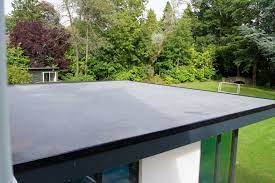Rubber roofing, also known as EPDM roofing, is a popular choice for commercial and residential buildings. It is a type of roofing material made from ethylene propylene diene terpolymer (EPDM), which is a synthetic rubber material that has excellent durability and weather resistance. Rubber roofing is a cost-effective and easy-to-install option for flat and low-sloped roofs, and it offers a range of benefits for building owners and property managers.
One of the primary benefits of rubber roofing is its durability. EPDM rubber is resistant to the damaging effects of UV rays, ozone, and extreme temperatures. This means that rubber roofing can last up to 50 years or more with proper maintenance, making it an excellent long-term investment for building owners. Rubber roofing is also resistant to punctures and tears, which can be a common problem with other roofing materials.
Another advantage of rubber roofing is its ease of installation. Rubber roofing can be installed quickly and efficiently, even on roofs with complex shapes and features. This can save building owners time and money on installation costs, as well as minimize disruption to building operations during the installation process. Rubber roofing can also be installed over existing roofing materials, which can save even more time and money on tear-off and disposal costs.
Rubber roofing is also an energy-efficient choice for buildings. EPDM rubber has a high reflectivity, which means that it reflects a significant amount of the sun’s heat and UV rays away from the building. This can help to reduce energy consumption and lower cooling costs during the summer months. Rubber roofing is also an excellent choice for buildings in colder climates, as it can help to prevent heat loss through the roof.
In addition to its durability, ease of installation, and energy efficiency, rubber roofing is also a low-maintenance option for building owners. EPDM rubber is resistant to algae and mold growth, which can be a problem with other roofing materials. This means that rubber roofing requires minimal maintenance over its lifespan. Which can save building owners time and money on repairs and upkeep. roofing material
Rubber roofing is also a sustainable choice for building owners who committ to reducing their environmental impact. EPDM rubber is recyclable, which means that it can repurposed and reus at the end of its lifespan. In addition, rubber roofing can be manufactured with recycled materials. Which can help to reduce the amount of waste generated during the production process. By choosing rubber roofing, building owners can help to minimize their carbon footprint and promote sustainable building practices.
Finally, rubber roofing is a cost-effective choice for building owners and property managers. Rubber roofing is one of the most affordable roofing materials on the market. And its durability and low maintenance requirements can save building owners money over the long term. Rubber roofing also offers excellent value for money, as it provides a range of benefits. That can help to improve the performance and efficiency of buildings.
In summary, rubber roofing is a durable, easy-to-install, energy-efficient, low-maintenance, sustainable, and cost-effective roofing option for commercial and residential buildings. With its excellent weather resistance, reflectivity, and resistance to algae and mold growth. Rubber roofing is an excellent long-term investment for building owners who are looking for a reliable and high-performing roofing material. Whether for a new construction project or a roof replacement. Rubber roofing is an excellent choice for buildings of all types and sizes.

